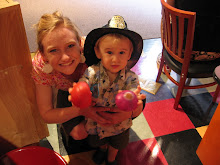So, I don't think I have adequately discussed the food that I have been eating here in Madagascar. Basically, I am soon going to turn into one massive grain of vary (the malagasy term for rice). As much as I am a lover of the fluffy white grain, I am pretty sure I have eaten more rice in the past two weeks than in my entire existance. For both lunch and dinner (and on some occasions breakfast), the meal commences with a huge plate of rice. There is always some portion of meat to accompany this mountain of fluff...zebu, chicken, sardines, shrimp, etc. Most of the time, the meat is served in conjunction with some sort of vegetable...beans, green papaya (which is kind of like spaghetti squash and oh so delicious), cucumbers and avacado, etc. Then, the meal is always topped off with fruit for dessert...pinapple, mango, papaya, guavas, bananas etc.
**disclaimer: Studying abroad does crazy things to people. I am now eating bananas. At my own free will. I am not joking. (For some of you, this may not seem like a big deal. But for those who know me well, I know what you are thinking at this moment. Yes even you Roman ;)...but fear not, I am still NOT eating peanut butter!
At the beginning of this trip, I thought that I might lose some weight (due to the fact that I would be eating healthier foods, etc.) I no longer feel like this is a true statement. While I am definitely eating less processed foods, I am eating A LOT of it! The food here is so tasty.
The past two days have been pretty calm here in Fort Dauphin and Libanona. The weather has calmed down from the cyclone, and the walks along the beach have been quite peaceful. My days have mainly been filled with lots of classes, eating, and hanging out around town with my american loves. We have actually been learning a lot about local NGOs (non-governmental organizations) and their projects throughout Fort Dauphin. We talked with a gentleman who started a local NGO called "Azafady" (which is actually the Malagasy word for "please" or "excuse me" or "not taboo"). His organization spends a lot of their time working with local villagers in a program that teaches health and sanitary practices. Not only does Azafady have to work to create these programs, but they must integrate their knowledge of the local culture, practices, and "taboo." It is easy to go into a village and build an outhouse. It is much harder to explain to a group of rural Malagasy villagers the importance of sanitation and the relevance of a clean living/eating space.
Classes have been getting harder. Malagasy is completely hard to learn. It is like no other language that I have ever encountered, and the structure of sentences, spelling, and pronunciation of words is quite difficult. For example, there are four different words for the term "cousin," depending on the gender of the individual and whether the cousin comes from the mother's side of the family or the father's side. Example #2: There is only one article in the entire language (gny)...I know this seems like it would be easier, but when it comes to translating this fact, is indeed, a bitch. Example #3: To say "see you later", you say: Mandrapihaona, ami-magnaraky koa.
Malagasy homelife has slowly become less and less difficult. The language barrier will always be a problem, but I am beginning to feel more at home.
...and on that note, it is time for me to go handwash some clothes. woot.
until my next adventure,
erin elizabeth
Wednesday, February 11, 2009
Subscribe to:
Post Comments (Atom)


1 comment:
Well i know what you will not be eating for awhile when you get back RICE haha.. OH erin sounds like a blast except for learning a whole nother language while french too. Reminds me of the good ol spanish class days. Oh i love and miss you sent you mail i pray you get it if you dont sorry but i sent you mail though haha.. Glad the food is yummy
Post a Comment